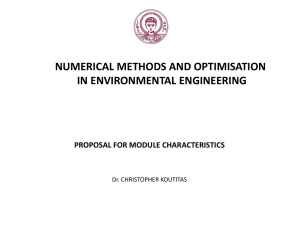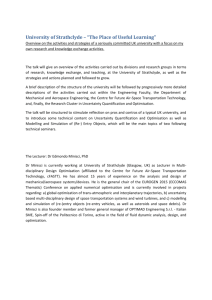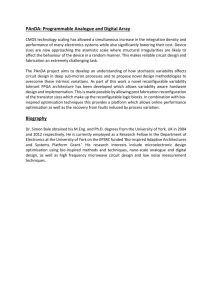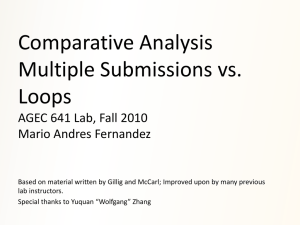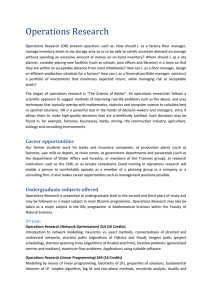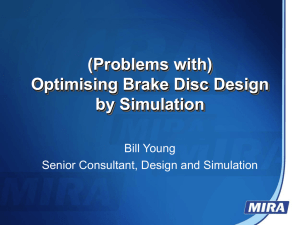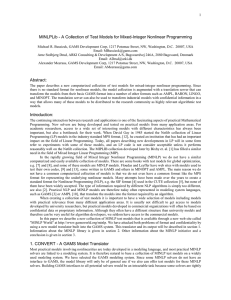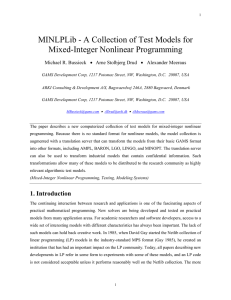Multi-objective MINLP optimisation of bio-ethanol from sugarcane bagasse combining rigorous and
advertisement
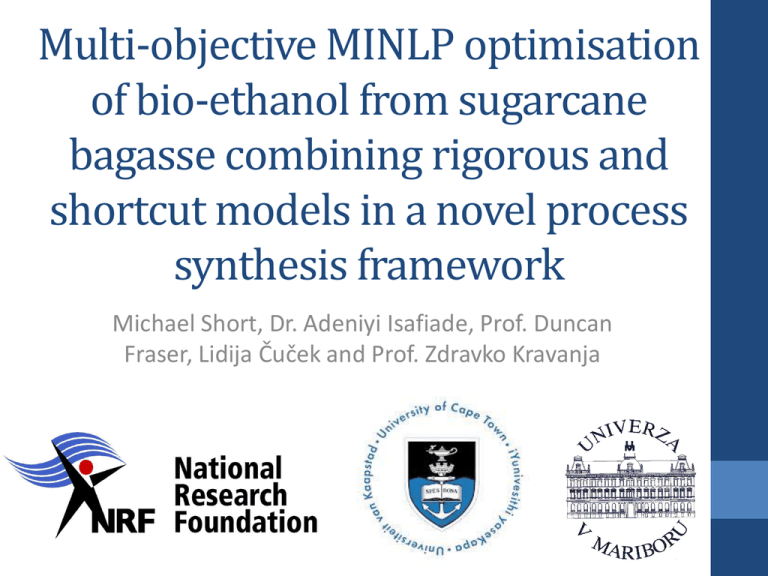
Multi-objective MINLP optimisation of bio-ethanol from sugarcane bagasse combining rigorous and shortcut models in a novel process synthesis framework Michael Short, Dr. Adeniyi Isafiade, Prof. Duncan Fraser, Lidija Čuček and Prof. Zdravko Kravanja Contents • EPSE at UCT • Background • Methodology • Key Questions • Progress E&PSE at UCT • Environmental: • Biogas • LCA • Sustainability • Process Systems Engineering: • Heat integration • Process integration and optimisation • Bioethanol The group’s work • Projects: • Bioethanol reactor modelling • Optimisation of reactor configurations • Makes use of kinetic models • Lignocellulose pre-treatment modelling • Process configurations • Regional network optimisation • Biorefinery simultaneous optimisation and simulation Optimisation/Simulation/LCA SIMULATION ECONOMIC OPTIMISATION ENVIRONMENTAL OPTIMISATION Process Design • Sequential • Process configurations limited • Integration usually limited • Heuristics often used • Single objective • Detailed simulation for final design Biofuels MINLP optimisation • Equations represent units • Variables: • Continuous variables – design specifications • Discrete variables – unit choices • Bounds and initialisations important • GAMS commonly used (Brookes, et al., 2008) Superstructures in optimisation Continuous variables - x Discrete variables - y MIPSYN • MINLP issues • • • • • • Non-convexities Local maxima and minima Difficulty ensuring global optimum Division by zero when process units cancel Reliant on good initialisations and bounds Bilinear terms • MIPSYN (Kravanja, 1990) MIPSYN USER MipSyn GAMS Input Exploits special Logic files structures in flowsheets: Gams Start Superstructure - Bilinear terms - Comprehensive bounding strategy Gams Restart NLP subproblem - Predictive Gams Restart Outer-approximations initialisations - Division by zero ZU – Upper Bound - Simultaneous Formulation of MILP heat integration Gams Restart MILP Master Problem ZL– Lower Bound GAMS Output files Gams Save Gams Save Gams Save Suboptimisation loop Gams Save Yes ZL ≥ ZU STOP No Multi-Objective Optimisation • Combining LCA with economic objectives (Azapagic, 1999) • MO methods: • Weighted-sum (Gonzalez-Campos, Ponce-Ortega et al., 2011) • Ɛ-constraint method (Čuček & Kravanja, 2010) Multi-Objective Optimisation 80% 90% Simultaneous Biorefinery Optimisation • Biorefinery regional networks optimised (Kravanja, Čuček, et al., 2010; Ponce-Ortega, et al., 2011) • Biorefineries for fuel blending (Zondervan, et al., 2011) • Biorefineries from corn and sugar (Martin, et al., 2008) • All simultaneous strategies: • Used gross simplifications • Few process options considered • Objective functions simplified Methodology (1) • Construct a superstructure • Include possible processing routes • Initial NLP problem • Skeleton/base plant • Identify problem areas for solvers • Economic and environmental objective functions • MINLP problem – shortcut models for process units Methodology (2) • Use simulations to validate and check shortcut models at optimum conditions • Use correction factors to adjust models in MIPSYN in the region of the optimum • Re-run MIPSYN problem and see results • Do this until convergence is achieved • Use Ɛ-constraint method for MO optimisation Objectives of project • Simultaneously optimise and evaluate the process flowsheet options • Use simulations to ensure models are accurate • Use both economic and environmental objective functions • Use this methodology on a variety of flowsheeting problems: • HENS • Hydroalkylation plant • Bioethanol production Key Questions • Will the optimal plant provide similar results to the “black box” approach of other researchers or will the inclusion of the simulation step drastically change the viability of certain traditional units used in biorefinery modelling? • How will the model converge and is it necessary to include acceleration techniques and which techniques would be most suitable to this task? • Will the inclusion of LCA result in the inclusion of some possible process options traditionally excluded? • Will it be better to produce bio-ethanol than using current cogeneration methods? • Is automated process synthesis a worthwhile pursuit? Current state of project • Methodology applied to HENS problem with limited success. • Bioethanol plant NLP formulation nearly complete. • Unanticipated size: Nearly 10 000 variables • Bounding and initialization time-consuming Acknowledgements • University of Cape Town • University of Maribor • The National Research Foundation • The National Laboratory of Science and Technology of Bioethanol (CTBE)

